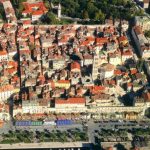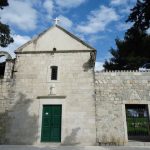The Temple of Jupiter is located just west of Peristil, at the end of a narrow passageway called Kraj Sveti Ivana accessible between the Skočibučić-Lukaris and Cipci Palace. Originally, there were three temples to the right of Peristil; Kibel, Venus, and Jupiter however, only the latter remains today.
The Temple of Jupiter was built around the 3rd century, about the same time is the palace itself. Jupiter was the name of Diocletian’s father and was also the highest Roman god, the god of the sky, and the god of thunder. This god was highly worshipped during the Imperial era until the Roman Empire came under Christian rule. Emperor Diocletian believed he was a reincarnation of Jupiter and thus positioned this temple directly adjacent to his mausoleum, not St. Domnius Cathedral.
The Temple of Jupiter is a miniscule rectangular temple with a very characteristic vaulted ceiling featuring a myriad of stone blocks, each with a different central motif. Boarding the ceiling and walls is a very ornate frieze all around. The temple is elevated as below it hides the crypt, which is a typical character of a Roman temple. The doorway features very intricate moldings that tell a story in itself. It is considered to be one of the best-preserved Roman temples in the world.
At the fall of the Roman Empire in the Middle Ages, the temple was converted into Saint John’s Baptistery (Sv. Ivan Krstitelj), named after the Archbishop of Split. This meant the addition of large 12th century baptismal font, which allowed for total immersion according to the Byzantine rite. Carved on the font is previous Croatian King Zvonimir and other notables at the time. Today, the font is used by visitors who make a wish by tossing in a coin.
Along the back wall are two medieval stone tombs where the remains of Bishop John (8th century) and Bishop Lawrence (11th century) lie. In between the two coffins is a large statue of John the Baptist by famous Croatian sculptor Ivan Meštrović.
Outside the entranceway lays a Roman sarcophagus and guarding the temple is a headless graphite sphinx (from 1500 BC), which Diocletian brought from Luxor. Directly next to the temple is Split narrowest street called “Pusti me proć,“ meaning let me through.
The temple is largely closed during the winter months however, they are open during the long tourist season and admission only costs 5KN.









